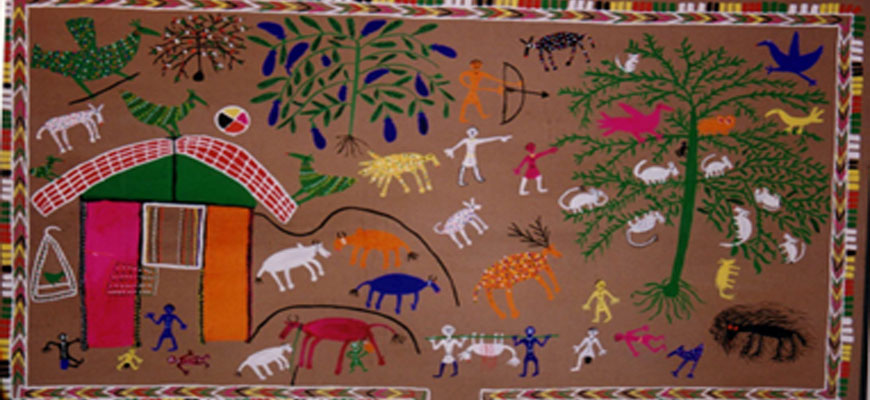Tribal are believed to be the oldest inhabitants of India. Their rich cultural tradition is manifest in their rituals, their songs and dances, their community deities, tattoos, myths and lore. They are simple people and mostly worshippers of Hindu deities. They celebrate birth, betrothals, marriages and holy fair and hunting expeditions with great fervor and enjoy their culture. They celebrate some of their festivals in honour of their departed ancestors. The popular forms of entertainment consist of story-telling combined with dance and music.
If they have any problem they narrate their problem to the badwa who offers solutions, which almost always involves through the painting of Pithoras on the walls of the house. The Pithora Baba is considered to be the reigning deity of the community and his presence is considered to be the solution of all problems. The first wall of the house is considered to be the right place for a Pithora. Pithora panting is however, considered to be a three-wall affair, so the first wall and the other two walls around it are prepared for the painting.
Pithora, a ritual wall painting depicted the myth of creation is very characteristic of Bhils and Bhilwaras of western MP and Rathwas of eastern Gujarat. The main theme of the painting is the marriage procession of Pithora and Pithori which is attended by the gods and other semi gods. This myth centers around the god Babo and his nephew Pithora and is connected with the fecundity of Mother Earth, who is impregnated by divine bull Nandyo. The ritual of the installation of divinities into the house by painting painted by their priest. In contrast to the Rathawas of Gujarat , the rendering of the painting by Bhils of Madhya Pradesh is simple and archaic.
Adiwasis Bhils (Bhils of Rajasthan, Gujarat and Madhya Pradesh)
The Bhils and Bhilalas of Dar and Jhabua in Madhya Pradesh and Rathwas of Punchmahal in Baroda district of Gujarat display characteristic ritual wall paintings created by traditional caste groups known as Lakhindra. Madhya Pradesh and Gujarat worship wedding deity “Pithora” whose images are painted on house wall on the occasions such as weddings.
Pithora paintings are thus considered auspicious and bring good luck and success to the family as well as the function.
Among bhils of Rathwa and Saora painting itself is called God. The act of painting is known as reading the god. Their festal movements when man can perform the primordial act of painting following the interpretation of his dream, a tribe man makes a picture. Primary patterns are revealed in dream or in trance. Artistic expression drew substance simultaneously both from music, narration and visual representation of the cosmos. At first place painter, the god himself wrote a pictorial history of the creation. Hence the content of the Rathwa paintings are limited to that description. The object of pictograph is the life in underworld as revealed to priest in dream or trance. The offering aim for the wellbeing of the family and fertility.
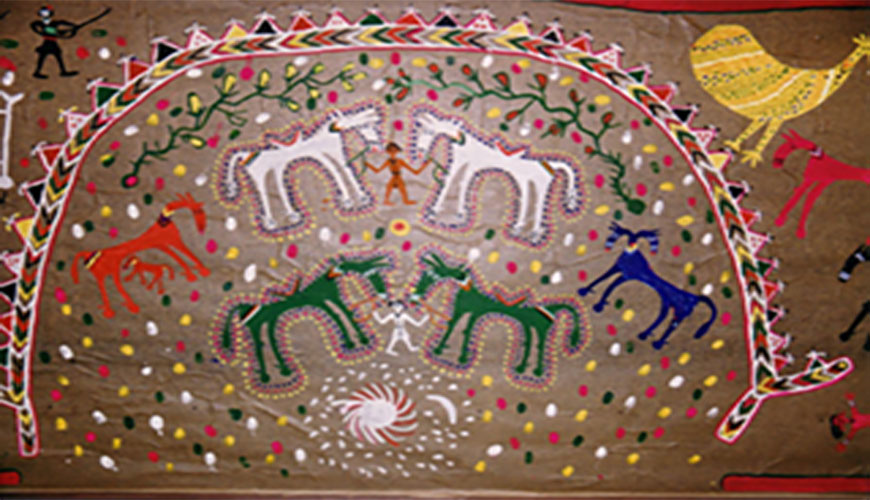
The paintings depict story of creation and myth thus depicted centers around the tribal god Baba and his nephew Pithora. The tribal artist work under the shadow of his god and ancestors. Originally patterns are revealed to him in dream or in trance. The Rathwa painter priest goes into trance and follow god in correct identification of each figure in Pithora painting.
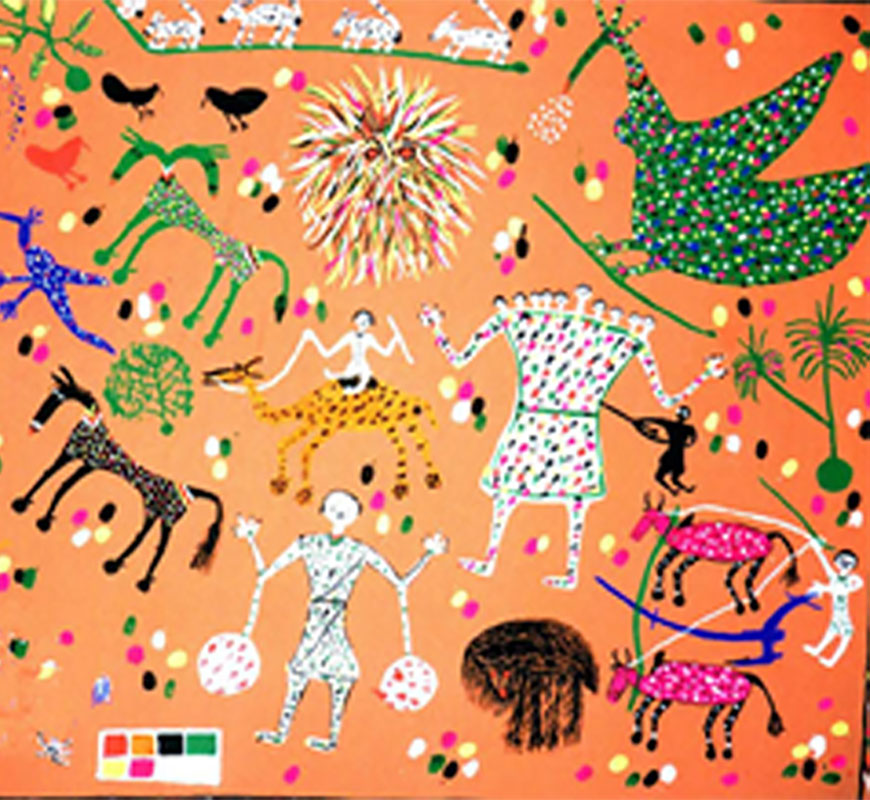
The main character of Pithora painting is horse in different sizes are used to draw the out lines. Everything connected with the Bhil life is painted – the Sun, the Moon, the animals, trees, insects, rivers, fields, mythological figures, the god, Bhilvat Deo Baramathya, who has twelve heads, Ektangya, who has only one leg. Do their work. The Udaipur Bhils decorate the walls of their houses and temples with images of the gods, flowers, animals and birds. They call these wall paintings mandno. Bhil mandno are stylized line drawings. Painting of the Soara tribesman depict contemporary connection between this world and under world. Priest paints the life in underworld revealed to him in deep trance.
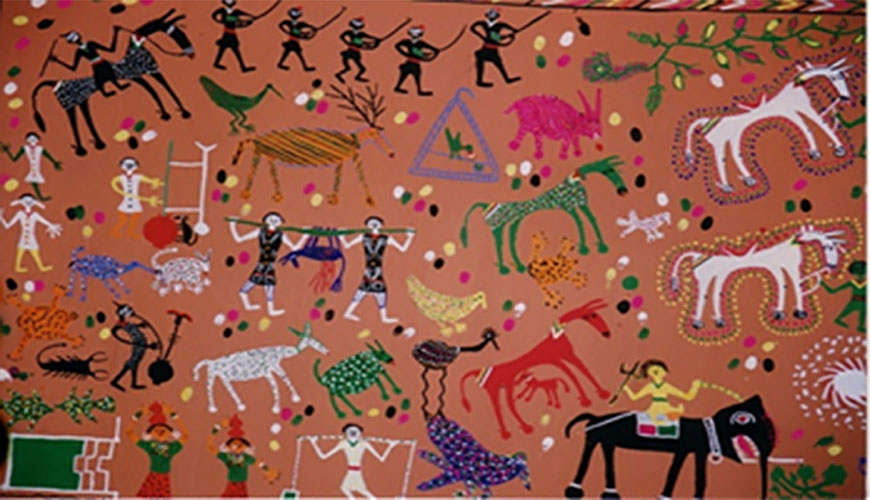
Rathawa’s Pithora paintings are ritual paintings done during rainy season on a house wall in which the image of horse and horse riders are commonly depicted. Wall paintings are made to propitiate the god Pithora on fulfillment of a wish, or seeking fulfilment of a wish. The iconography is prescribed by the ritual myths, and legends from the collective memory of the tribe, passed from generation from generation. Section or approval is obtained from the tribe priest, who is in a state of trance becomes god Pithora himself and inspect the purity of the ritual elements and his grammar of the iconography is maintained. He is least interested in aesthetics or stylistic aspect of the paintings. The main characters of Pithora are luxuriously colourful and ornamented horse and horse riders. Traditionally Pithora was installed on the walls of the house. Each character has to be illustrated according to myth.
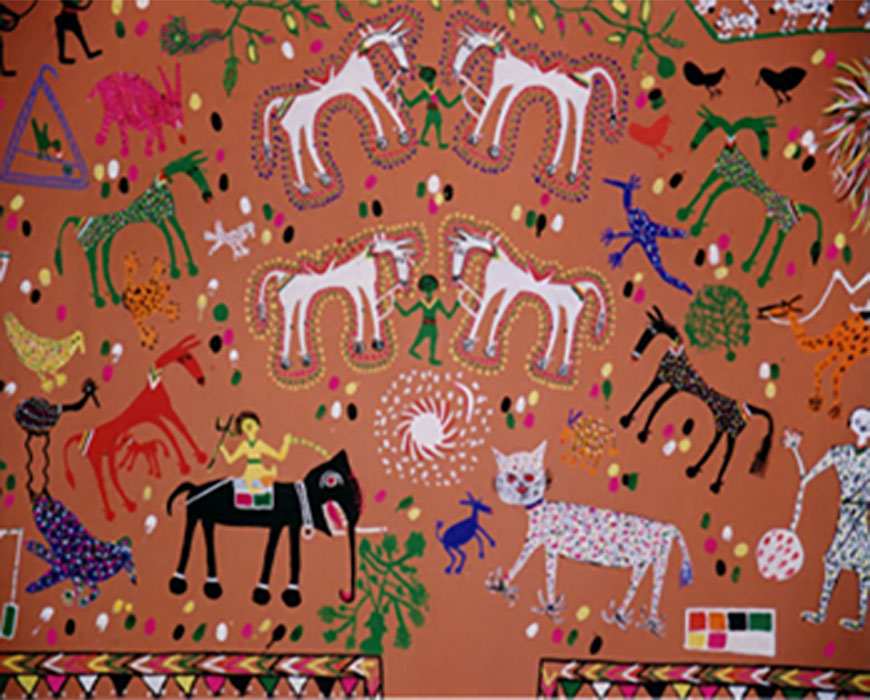
Among the Bhils of Jhabua, Pithora painting is a ritual held in great esteem. Pithora horses are painted by the lekhindra, the traditional painter, and offered to the devas. As the story goes, in the kingdom of Dharmi Raja, people had forgotten how to laugh or sing and dance. Pithora, the prince, then undertakes a journey on horseback to the abode of the goddess Himali Harda, who gives them back their laughter, songs and dance
Saora and Bhils of Rathwa painting itself is called God. The act of painting is known as reading the god. Their festal movements when man can perform the primordial act of painting following the interpretation of his dream, a tribe man makes a picture. Primary patterns are revealed in dream or in trance. Artistic expression drew substance simultaneously both from music, narration and visual representation of the cosmos. At first place painter, the god himself wrote a pictorial history of the creation. Hence the content of the Rathwa paintings are limited to that description. The object of pictograph is the life in underworld as revealed to priest in dream or trance.
The tribal artist work under the shadow of his god and ancestors. Originally patterns are revealed to him in dream or in trance. The Rathwa painter priest goes into trance and follow god in correct identification of each figure in Pithora painting. Painting of the Soara tribesman depict contemporary connection between this world and under world. Priest paints the life in underworld revealed to him in deep trance. Bhils of western India when they paint their Pithoras, they include in the corner a copulating man and woman. They give explanation that without this the world would not be.


